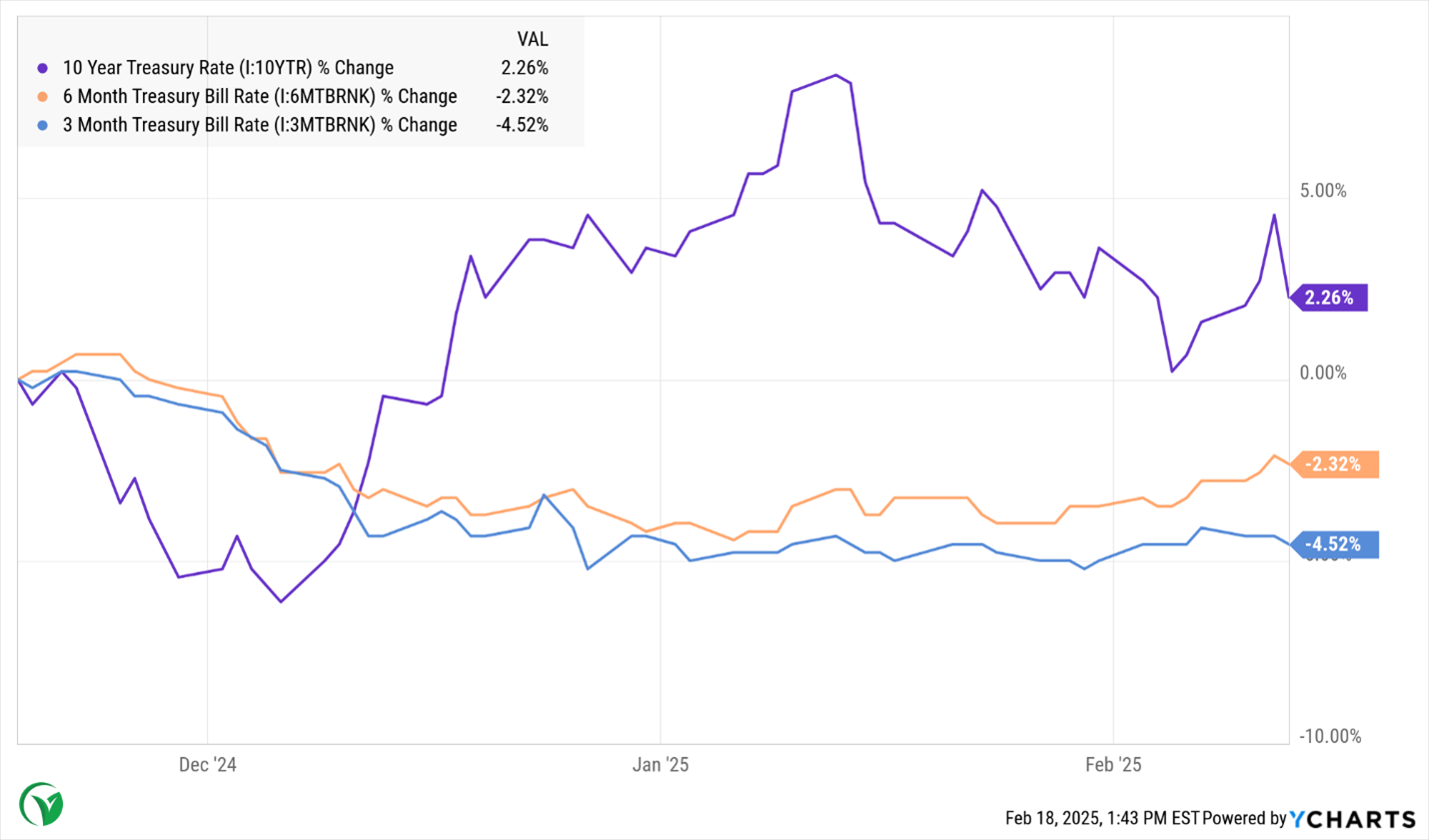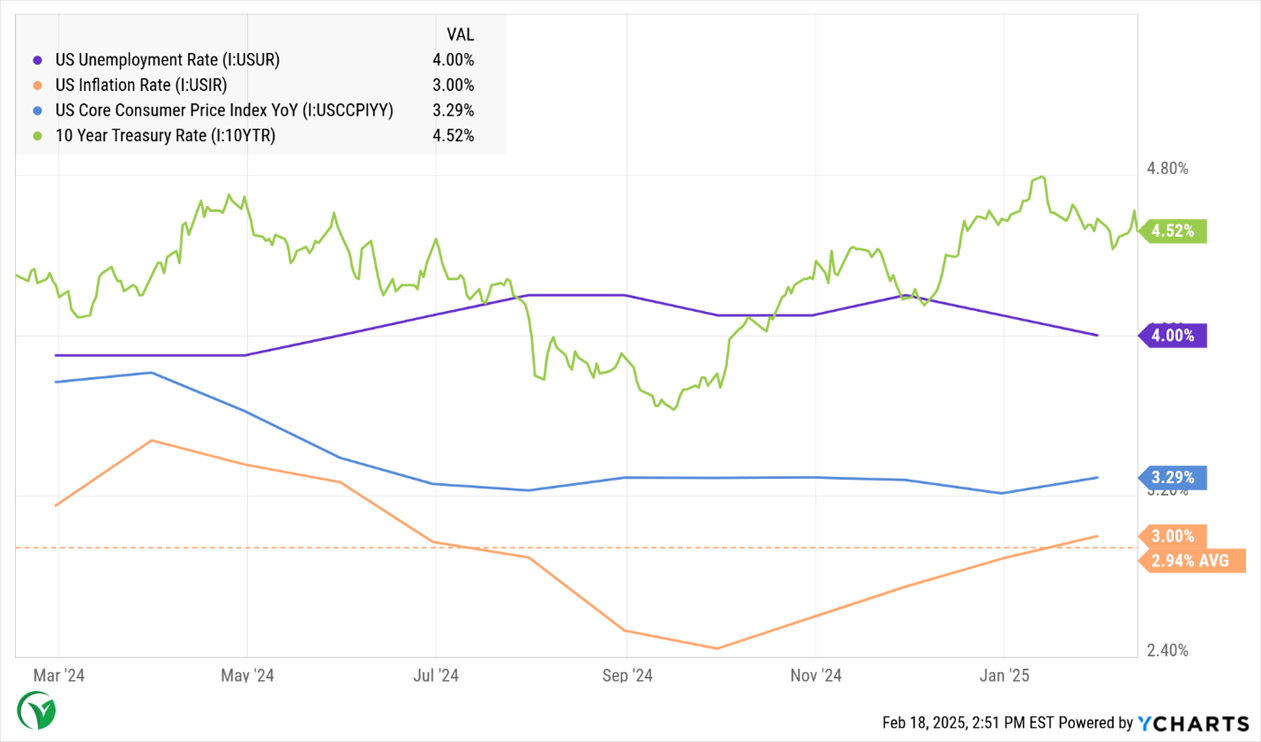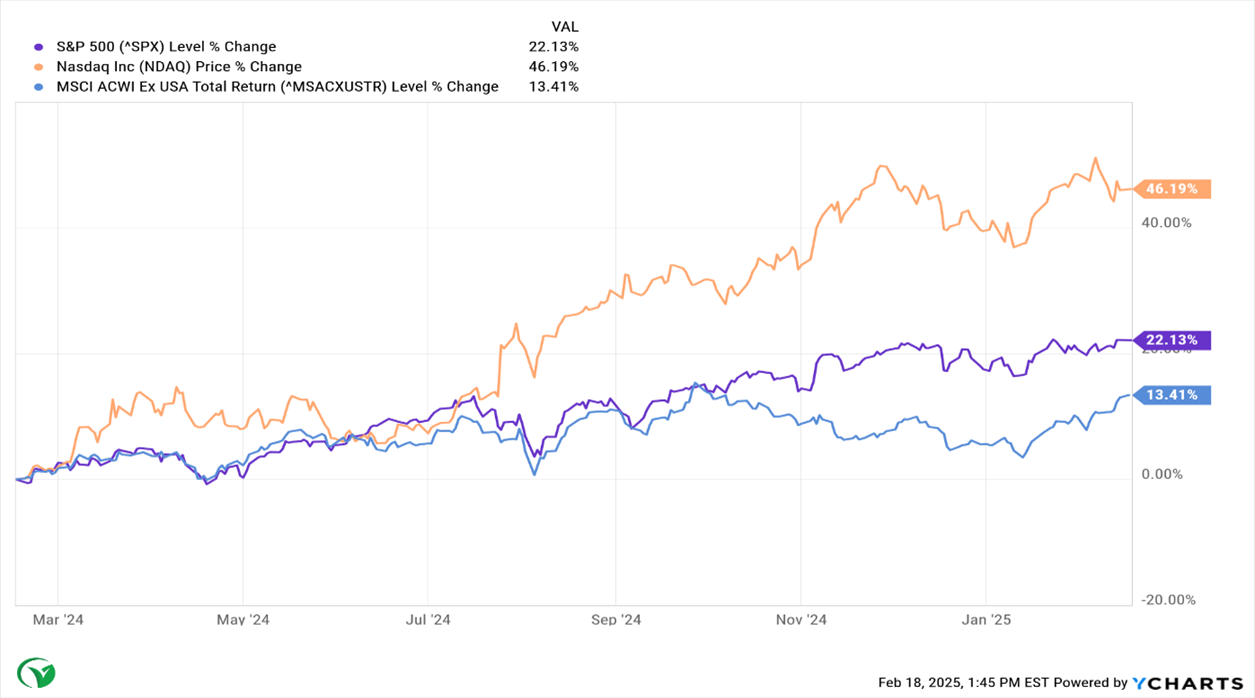
As we progress through 2025, economic developments continue to align with the themes highlighted in our 2025 Market Commentary. Trade policies, including the reinstatement of aggressive tariffs, and the fiscal tightening measures introduced by the Department of Government Efficiency (DOGE) are shaping market sentiment. A temporary rise in inflation remains a focal point, with the Federal Reserve carefully balancing economic growth and price stability through measured policy adjustments. These factors collectively contribute to an evolving macroeconomic landscape that demands strategic investment approaches.
Market volatility, driven by trade disruptions and fiscal austerity, is unfolding as expected. The impact of tariffs on supply chains is becoming evident, particularly in the energy and industrial sectors, where higher input costs are pressuring margins. Meanwhile, DOGE’s cost-cutting initiatives are affecting employment trends and Treasury yields, further underscoring the significance of government spending adjustments. In this environment, our investment strategy remains centered on resilience, diversification, and proactive asset allocation, ensuring that portfolios are well-positioned to manage risks and capitalize on opportunities.

Vita Financial
Investment Committee and
Private Wealth Group
Tariff and Trade
The reinstatement of aggressive tariffs is materializing as a key market disruptor, reinforcing our forecast of heightened trade tensions and cost pressures across industries. President Trump’s Fair and Reciprocal Plan has imposed significant tariffs on imports from Canada, Mexico, and China, with China facing a 10% tariff and steel and aluminum imports subject to a 25% duty, impacting nearly $60 billion in goods. While Canada and Mexico negotiated a temporary pause, the EU is preparing retaliatory measures, signaling ongoing volatility in global trade.
The global business community is bracing for increased costs and supply chain disruptions. The energy sector, heavily reliant on steel and aluminum for infrastructure, is expected to face higher costs, potentially increasing project costs by up to 7%. The Trump administration’s approach suggests a continued focus on leveraging tariffs to renegotiate trade deals and reduce the U.S. trade deficit. Investors should anticipate market volatility, with potential impacts on global trade dynamics and economic growth. The administration’s commitment to a data-driven assessment of trade relationships indicates that further adjustments to tariffs and trade policies are likely in the coming months.
Given these developments, it is advisable for investors to closely monitor trade negotiations and consider diversifying their portfolios to mitigate potential risks associated with increased tariffs and trade tensions. Staying informed about responses from key trading partners and potential retaliatory measures will be crucial in navigating the evolving trade landscape. The steel and aluminum tariffs could have significant implications for sectors like construction, automotive, and energy, leading to higher costs and potential delays in projects. For consumers, these tariffs could result in a 5-10% increase in prices for goods reliant on these metals.
Department of Government Efficiency (DOGE) – Savings, But at What Cost?
One of the standout stories has been the progress of DOGE and its implications for cost-cutting efficiency. This has significantly influenced key market indicators through its initiatives. As of fiscal year 2024, federal spending was $6.8 Trillion with a $1.8 Trillion deficit. Early measures made by DOGE, including a hiring freeze and a 1:4 hiring ratio, have led to $5.6 Billion in initial savings. The reduction in the federal workforce has led to short-term increases in unemployment, particularly in regions with high concentrations of federal employees. Dismantling programs such as USAID have also led to service reduction in addition to significant job losses. This has had an adverse effect on many communities both domestic and international. The initiative’s access to sensitive taxpayer data has raised privacy concerns and has sparked legal challenges that are undermining DOGE’s credibility as a government organization. Furthermore, the cancelation of diversity, equity, and inclusion initiatives is reversing the progress already made toward a more inclusive workforce. On the surface, it may seem that the cost-saving measures are beneficial, but the current effects on economic impact and social equity carry substantial risks and consequences. Due to the uncertainties posed by DOGE’s actions, we are observing a tightening supply of T-bills leading to a decrease in yields, Treasury yields dropped, with the 10-year yield falling to 4.48%. With rising demand, T-bill prices have surged, reflecting a market pivot towards safer investments amidst these prevailing uncertainties.

Fig. 1.1 – Change in 10 Year Treasury Rate Vs T-Bill Rates
Federal Reserve Meeting
February’s inflation and monetary policy landscape reflect ongoing economic shifts, with inflation holding at 3.0% year-over-year and core CPI at 2.8%. Persistent supply chain pressures and rising costs from newly implemented tariffs continue to drive price levels upward. The labor market remains resilient, with unemployment falling to 4.0% and 143,000 jobs added. However, consumer sentiment appears cautious, as evidenced by a 0.9% decline in retail sales. Meanwhile, strong corporate earnings have helped push the S&P 500 closer to record highs, demonstrating market adaptability amid broader economic uncertainties.
The Federal Reserve remains measured in its approach, recognizing that while inflation has moderated, it remains above the 2% target. The current federal funds rate remains between 4.25%-4.5% as the Fed evaluates further adjustments. Treasury yields have reacted accordingly, with the 10-year yield falling to 4.48%, reflecting increased investor demand for fixed-income assets in response to trade and fiscal policy changes. As inflationary pressures and policy shifts continue to shape the economic landscape, investors should stay alert, as monetary policy decisions will be pivotal in determining market direction throughout 2025.

Fig 1.2 – Key Economic Indicators

Fig. 1.3 – Current Market Performance Indicators
Impact of Deregulation – An opportunity
While looming policies look to shake up emerging sectors in 2025, deregulation initiatives in key industries such as Artificial Intelligence, Semiconductors, and Defense are set to impact market dynamics. Under the Trump administration, the removal of stringent regulations in the AI sector will foster innovation and reduce compliance burdens, potentially allowing for a more competitive market. While facing uncertainty from tariff policies, the semiconductor industry also has an opportunity for robust growth due to the increasing demand for AI chips and data center expansions. The opportunity lies in the fact that deregulation is likely to enhance the production efficiency and global market positioning of the semiconductor manufacturing and distributing space. In the defense sector, particularly in military AI applications, we can expect to see growth in innovation as the rapid progress falls in line with broader national security goals. These changes lead us to believe that reduced regulatory constraints have the potential for higher profitability and expansion across these industries.
Moving Forward – Our outlook for investors
The trajectory we outlined in January is unfolding, with trade disruptions, fiscal austerity, and inflation management dominating market dynamics. Tariffs on key imports are raising costs, potentially fueling inflation and challenging corporate margins, while DOGE’s cost-cutting measures are altering labor market conditions and Treasury yield movements. The Federal Reserve’s cautious stance reinforces the delicate balancing act required to sustain economic stability.
For investors, the key lies in identifying sectors resilient to these policy shifts. Technology, particularly AI and semiconductor industries, continues to present long-term opportunities despite near-term market fluctuations. Healthcare, bolstered by cost-efficiency initiatives, remains a defensive stronghold. Meanwhile, fixed-income strategies remain compelling in an environment where Treasury yields and corporate bond spreads offer attractive risk-adjusted returns.
As the year progresses, volatility is likely to persist, driven by ongoing trade negotiations, fiscal adjustments, and geopolitical developments. A disciplined approach centered on fundamentals, diversification, and strategic asset allocation will be essential in capturing opportunities while safeguarding against downside risks.
Key Market Indices





*Market Indices as of 2/28/2025
This is intended for informational purposes only and should not be used as the primary basis for an investment decision. Consult a financial professional for your personal situation.
Past performance does not guarantee future results. Indices mentioned are unmanaged, do not incur fees, and cannot be invested into directly.
Graphs provided by YCharts.
Key Market Indices according to Google Finance.
Securities offered through Registered Representatives of Cambridge Investment Research, Inc., a broker/dealer, member FINRA/SIPC. Advisory services through Cambridge Investment Research Advisors, Inc., a Registered Investment Advisor. Cambridge and Vita Financial are not affiliated. The information in this email is confidential and is intended solely for the addressee. If you are not the intended addressee and have received this email in error, please reply to the sender to inform them of this fact. We cannot accept trade orders through email. Important letters, email, or fax messages should be confirmed by calling (678) 250-5099. This email service may not be monitored every day, or after normal business hours.
